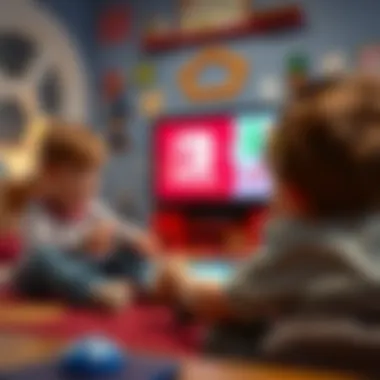Top Nintendo Games Perfect for Four-Year-Olds


Intro
When it comes to choosing games for young kids, especially four-year-olds, parents often find themselves caught in a web of options. Nintendo, renowned for creating family-friendly content, has an impressive lineup tailored for the littlest gamers. But how does one sift through the colorful chaos to find titles that don’t just entertain but also educate?
This article dives into the vibrant world of Nintendo games suitable for four-year-olds, focusing on factors like gameplay, educational value, and content appropriateness. From heartwarming adventures featuring beloved characters to puzzle games that stimulate critical thinking, there’s a lot to unpack. The primary goal here is to help parents make informed decisions, ensuring their little ones have engaging yet developmental gaming experiences.
We'll explore a selection of games, assessing their mechanics and benefits, and highlight what sets them apart from the rest. Whether it’s through cooperative gameplay, vivid graphics, or simple controls, finding the right game can unlock a treasure trove of joy and learning for both kids and their caregivers.
So, if you're ready, let’s dig in and take a closer look at some standout choices for your four-year-old’s Nintendo journey.
Understanding the Target Audience
When selecting games for young children, especially four-year-olds, understanding the target audience is crucial. It's not simply about finding something colorful or popular; it’s about recognizing the unique developmental phases children go through at this age. Each child's abilities vary, but there are common milestones and characteristics prevalent at this stage that greatly influence their gaming experience. By focusing on these elements, one can ensure that the choices made are beneficial for both learning and entertainment.
Developmental Milestones for Four-Year-Olds
Four-year-olds are in a dynamic stage of development. Around this age, children often demonstrate a better grasp of verbal skills and might be able to engage in basic conversations. They’re also learning to express their thoughts and emotions more clearly, which might reflect in their gaming preferences and the types of interactions they enjoy. Key developmental milestones for this age group include:
- Language Skills: Expanding vocabulary and ability to communicate.
- Social Skills: Learning to share, take turns, and cooperate, which can translate into games that require teamwork or multiplayer options.
- Motor Skills: Improved hand-eye coordination, which is vital for gameplay involving physical controls. Children can navigate menus and handle characters more proficiently than in earlier years.
Understanding these milestones helps in picking games that can further enhance these skills. For instance, a game that encourages conversation or collaboration among players can be more engaging and suitable for a child’s developmental needs.
Cognitive and Motor Skills at This Age
At four years old, cognitive development is gaining momentum. Kids start to engage in more complex problem-solving and can understand basic patterns and sequences. Their cognitive growth can be nurtured through games that challenge them—simple puzzles or platformers that require critical thinking and planning are the perfect fit. Here are some important aspects regarding cognitive and motor skills:
- Cognitive Growth: Kids begin to think logically about their surroundings. They can categorize objects, understand cause and effect, and even begin to grasp simple math concepts. It’s important that games stimulate their minds, allowing them to think critically as they play.
- Motor Skills: Their fine motor skills are becoming more refined. Coordination when using controllers or touch screens should be considered when selecting games. Engaging with games that require precise movements can further enhance these abilities.
Ultimately, an understanding of cognitive and motor skills allows parents to find games that align with their children’s abilities, making playtime both fun and educational. The right game can make all the difference in supporting the growth of these vital skills.
Criteria for Game Selection
When it comes to choosing the right games for young children, it’s crucial to keep several factors in mind. Especially with four-year-olds, there’s a delicate balance that needs to be struck between fun and learning. A thoughtful selection can provide not only entertainment but also valuable developmental experiences. The criteria for selecting appropriate games will guide parents and caregivers through this process, ensuring that every gaming moment contributes positively to a child’s growth.
Age Appropriateness
Selecting games that are age-appropriate is like picking the right hat for a sunny day—it just fits. Four-year-olds are at a stage of rapid development, both cognitively and emotionally. Games suited to their age help match their growing abilities and interests. Aspects to consider include:
- Content: Games should feature themes and characters that resonate with young children. For example, bright colors and familiar creatures—such as Mario or animals—can capture a child’s imagination.
- Complexity: At this age, children are still learning how the world works. If a game is too demanding, it might lead to frustration rather than enjoyment. Opt for titles with simple objectives and straightforward mechanics that encourage exploration and play.
- Guiding Principles: In many cases, incorporating guiding principles—like teamwork or kindness—can enhance the experience. Children engage better when they understand the values behind their activities.
Gameplay Simplicity
Another core aspect when selecting games is gameplay simplicity. Young children have short attention spans and are often still developing their fine motor skills. Complicated controls and multi-layered tasks can inadvertently lead to disengagement.
- Intuitive Controls: Games should be easy to navigate. Imagine a game where a four-year-old struggles to perform basic actions—this can quickly become a source of discouragement. Hence, responsive and simple controls—like tapping or swiping—are essential.
- Clear Objectives: A straightforward goal can keep kids motivated. Games where they can quickly grasp what they need to do, such as collecting items or solving simple puzzles, keep them engaged. It's akin to a treasure hunt—if the clues are too vague, it can sap the excitement.
Educational Value
Selecting games with educational value can feel like hitting two birds with one stone. The right game can offer fun while encouraging learning. This aspect is often overlooked but plays a crucial role in a child's development. Here’s what to consider:
- Skill Development: Look for games that enhance critical skills, such as problem-solving, creativity, and spatial awareness. For example, a game that promotes strategizing can help develop cognitive skills in a fun way.
- Interactive Learning: Games that promote interactive learning—like counting, basic math, or even language skills—provide a playful twist on education. A title that subtly encourages counting or word recognition can be more effective than traditional methods.
- Collaborative Features: Many games encourage players to collaborate, which fosters social skills. These features allow children to learn not just from the gameplay but also how to cooperate and communicate with peers.
Opting for games that are age-appropriate, simple to play, and packed with educational content can make a significant difference in a child's gaming experience, nurturing both fun and growth.
Top Nintendo Games for Four-Year-Olds
When it comes to selecting the right games for young children, particularly four-year-olds, there are several key aspects to keep in mind. Video games serve not only as a form of entertainment but also as a medium for learning and development. By choosing games that resonate with the cognitive and emotional needs of children at this age, parents can provide an enriching experience that fosters growth. The engagement factor is crucial; after all, keeping a child interested and active in their play is paramount to any learning outcome.
Moreover, the Nintendo gaming platform offers a unique blend of colorful characters, playful storytelling, and interactive environments that can capture a child’s imagination. This section delves into specific titles that shine in the category of suitable games for four-year-olds, taking into consideration their gameplay mechanics, educational value, and user-friendly design.


Super Mario Odyssey
Gameplay Overview
Super Mario Odyssey introduces players to a vibrant and diverse world where exploration is at the heart of the game. The core gameplay involves Mario traveling across various kingdoms, collecting power moons to rescue Princess Peach. This open-world format encourages curiosity and exploration, which are natural tendencies for four-year-olds.
A standout aspect of this game is its straightforward yet engaging controls that allow young players to jump, run, and interact with their environment with minimal complexity, making it accessible for the youngest gamers. The side adventures in each kingdom can also spark a child’s sense of wonder and discovery, making it easier for them to connect with the game more deeply.
Key Features
The key features of Super Mario Odyssey include diverse worlds, each filled with unique challenges and secrets. Players encounter a variety of characters and puzzles that require problem-solving skills, thereby enhancing cognitive development. The ability for players to embody different characters adds layers of creativity and enjoyment.
What's essential about this game is its encouragement of play through trial and error. Children can feel a sense of achievement when they successfully navigate challenges, thus boosting their confidence.
Learning Opportunities
In addition to entertainment, Super Mario Odyssey is ripe for learning opportunities. Children can develop motor skills as they control Mario through complex terrains and obstacles. The game also encourages critical thinking as kids learn to strategize and figure out the best paths through various levels.
Another plus is the underlying themes of friendship and teamwork throughout the game. It’s a fun way to teach kids about collaboration, even if it's just through Mario's interactions with others in the game.
Animal Crossing: New Horizons
Gameplay Overview
Animal Crossing: New Horizons offers a completely different gameplay experience compared to action-oriented games. Here, players take on the role of a character who moves to a deserted island, where they can build, gather resources, and customize their environment at their own pace. This laid-back simulation fosters creativity in a stress-free setting.
The simple mechanics allow even the youngest players to grasp the fundamentals quickly. They can engage in daily activities, like fishing or gardening, leading to various rewards at their fingertips. The charm lies in its inclusiveness and the gentle rhythm at which the game unfolds.
Social Interaction
One of the most delightful aspects is how it encourages social interaction. Young players can develop social skills by interacting with anthropomorphic animal characters, forming relationships, and helping them with tasks. The online multiplayer option adds a layer of sharing and creating together, perfect for encouraging friendships among young players.
Letting children collaborate online can show them the value of cooperation and social dynamics even at a tender age. However, it’s important for parents to supervise these interactions to ensure safe gaming experiences.
Creative Expression
This game is genuinely a canvas for creativity. Children can design their homes, decorate their surroundings, and create their mini-worlds. The customization options not only foster a sense of ownership but also stimulate imaginative play.
Unfortunately, one downside may be the expansive nature of the game, which can be overwhelming for some kids. Nonetheless, the ability to explore freely is itself a skill-building treasure.
Kirby Star Allies
Gameplay Overview
Kirby Star Allies presents a delightful gameplay experience focused on co-op play, allowing a group of characters to work together to defeat enemies and solve puzzles. Its friendly atmosphere makes it particularly suited for younger gamers. This game features colorful visuals and lighthearted animations that appeal to children.
Through simple mechanics, like the ability to jump and inhale enemies, Kirby quickly becomes an easily relatable and lovable character for young audiences.
Team Play Benefits
Team play is one of the game’s most significant highlights. A child can control Kirby and invite friends to join as various copy abilities, creating a collaborative atmosphere that teaches young players the importance of teamwork. This promotes sharing, takes turns, and cooperation—fundamental skills for social development.
A potential challenge could be managing gameplay dynamics when friends jump in. Yet, generally, it adds a level of excitement for young players who appreciate the company.
Color Recognition
An impressive element of Kirby Star Allies is its use of color in gameplay. As characters change forms, the vibrant colors can help kids enhance their color recognition skills. This aspect can be particularly valuable for younger audiences who are still mastering their color identification.
Yoshi's Crafted World
Gameplay Overview


Yoshi's Crafted World presents a whimsical adventure characterized by its unique art style that mimics a crafted environment made of cardboard and paper, sparking curiosity and creativity in kids. The core gameplay revolves around platforming and collecting items, guiding players through imaginative landscapes.
This method ensures that players can practice their fine motor skills as they navigate through the game, making it suitable for four-year-olds. The child-friendly interface supports better engagement and eases the learning curve.
Puzzle Elements
One of the game’s standout features is its integration of puzzle elements. While kids journey through the crafted world, they encounter puzzles that require observation and critical thinking to solve. This can help enhance their cognitive abilities as they learn how to navigate challenges.
However, some kids might find certain puzzles complex, so a parent’s guidance might be beneficial at times, creating a collaborative problem-solving opportunity.
Artistic Engagement
The artistic appeal of Yoshi's Crafted World lies in its unique graphics and ability to stimulate imagination. Children can appreciate the art design, encouraging them to engage with their creative sides, both inside and outside the game.
Overall, the game excels in offering a platform for creative expression while also challenging players through enjoyable puzzles, rendering it an excellent addition to the gaming roster for young ones.
LEGO City Undercover
Gameplay Overview
LEGO City Undercover combines the charm of LEGO with an engaging narrative where players take on the role of an undercover cop to thwart criminals. The fun, colorful world filled with LEGO bricks makes it especially appealing to young children who adore building and exploration. The gameplay is simple enough to follow, making it an ideal pick.
The mechanics of exploration and collecting studs can keep kids hooked while promoting an active involvement in their gameplay experience.
Exploration and Discovery
As a sandbox-style game, LEGO City Undercover encourages exploration. Young players can roam around the city, discovering new locations, mini-games, and collectibles. This free-play format allows their natural curiosity to thrive as they delve into the various nooks and crannies of the LEGO world.
Kids can face minor challenges without much stress, thus making failure part of the learning process, which is essential for emotional growth.
Problem-Solving Skills
The game cleverly integrates various puzzles and missions that require players to think critically and come up with solutions to progress. This enhances logical reasoning and decision-making skills in a fun and engaging manner. Kids learn that perseverance is key as they sometimes fail before they find success.
Each unique mission scenario also introduces various life situations children may relate to, further enriching their overall experience.
Evaluating Game Mechanics
When it comes to selecting games for four-year-olds, evaluating game mechanics is paramount. At this age, children are not only developing cognitive and motor skills, but they are also learning how to interact with digital content. If a game is too complex or has mechanics that are not intuitive, it can lead to frustration rather than enjoyment. Thus, it’s crucial to analyze the components of these games to ensure they align with the developmental capacities of young players.
First, let’s discuss the significance of user interface design. A well-designed user interface helps kids navigate the game smoothly without getting confused or lost in unnecessarily complicated menus. Colorful icons, simple layouts, and clear instructions can boost a child’s ability to comprehend and engage with the gameplay effectively. After all, if they feel at a loss, they will likely lose interest fast.
User Interface Design for Young Gamers
The user interface (UI) in gaming can be compared to a map in a new city; it guides players to their destination without getting them tangled up in the streets. For young gamers, a successful UI in Nintendo games should be:
- Visually Engaging: Bright colors and friendly characters can keep a child's attention. Kids are drawn to visuals, so imaginative graphics can enhance their gaming experience.
- Simplified Navigation: Straightforward menus and clearly labeled options let young players pick up and play without needing parental guidance every step of the way.
- Feedback Mechanisms: Sounds and animations that signal successful actions help children understand the cause and effect in the gameplay. This reinforces learning while keeping them engaged.
An example of this can be found in games like Animal Crossing: New Horizons, where the UI is intuitive, allowing children to interact with the game world easily, thus providing a smooth experience tailored to their capabilities.
Control Schemes and Accessibility
Next up is the control schemes and accessibility, critical elements that impact how four-year-olds interact with games. Control schemes must be straightforward enough for little hands to manage while still offering depth when they start exploring further. Here’s what to consider:
- Simple Controls: Games should primarily use a few buttons or gestures. The less complicated, the better. Young players can get overwhelmed quickly, so limiting the number of controls minimizes confusion.
- Adaptive Features: The option to adjust difficulty and control sensitivity is essential. This means that as a child grows, their gaming experience can grow with them without forcing them to leave certain games behind.
- Physical Accessibility: If a game requires too much coordination or fine motor skills, it might be difficult for some children. Accessibility features that accommodate different physical abilities improve inclusivity.
Games like Kirby Star Allies excel at this, allowing children to jump in with basic control but also offering cooperative gameplay to help them learn teamwork, thus enhancing their experience.
"A thoughtfully designed game interface not only captivates kids but also encourages skill acquisition and social interaction, creating a well-rounded play experience."
By dissecting and evaluating these game mechanics, we can iron out the finest choices that will help nurture four-year-olds’ skills while ensuring that their gaming time is not only enjoyable but also educational. In the end, it's about striking the right balance between fun and cognitive development in their gaming journey.


Parental Guidance and Involvement
Parental guidance plays a crucial role when it comes to children's gaming, particularly for four-year-olds who are just starting to explore the digital world. It's not just about choosing the right games; it's also about understanding their content, setting boundaries, and actively engaging with kids to enhance their gaming experience. By being involved, parents can ensure their children not only have fun but also reap developmental benefits from their gaming adventures.
One important consideration encompasses the age-appropriateness of the games. While titles may appear innocent and entertaining, they can sometimes include themes or content that is unsuitable for a young audience. This makes it vital for parents to familiarize themselves with the games. They ought to play alongside their children at times, allowing them to gauge the content's suitability while also sharing in the experience. Engaging in this together fosters a bond and helps parents understand the themes and challenges their kids may encounter.
Among the skills children can develop through gaming are problem-solving, spatial awareness, and even basic social skills when they play with family or friends. Encouraging children to talk about what they are doing in the game gives them a chance to express themselves while learning to articulate their thoughts. This simple practice can help parents monitor their children's emotional reactions and desires, paving the way for deeper conversations about their gaming habits and interests.
"Active parental involvement is akin to being the kid's co-pilot on their gaming journey. It's not just about sitting back and watching; it’s about steering the ship together while ensuring a safe voyage."
By establishing a routine for gaming, parents can make it part of a balanced lifestyle. This encompasses conversations around what their child is experiencing in the game and how to apply those lessons in real life. Watching out for excessive screentime, especially given the rising presence of screens in daily life, is crucial too. When parents set the tone, they're creating an environment that promotes healthy gaming habits while ensuring their kids enjoy what they're playing without getting lost in it.
In summary, parental guidance and involvement form the backbone of a healthy gaming environment for young children. It's not merely about entertainment – it's an opportunity for growth, learning, and connection. By being engaged, parents can help their children navigate their gaming experiences while ensuring that the journey is educational and joyful.
Understanding Game Content
To maximize the benefits of gaming for their young ones, understanding the content of each game is fundamental. Parents should take the time to review game descriptions, ratings, and user reviews. The Entertainment Software Rating Board (ESRB) provides a clear classification system for games, indicating the appropriate age for viewers and content warnings.
- Content Ratings: Games typically have labels like E for Everyone or E10+ for ages ten and older.
- Content Descriptors: These show specific content like violence, mild language, or themes that might not be suitable.
When parents grasp this information, they can make informed choices that align with their family values and the individual needs of their children. Conversely, overlooking this element can lead to exposing kids to materials that could confuse or distress them.
Establishing Playtime Limits
Getting into a routine with gaming is another thing that can't be overlooked. It's no secret that once kids start playing, they can lose track of time faster than you can say "Mario Kart." To keep gaming from overrunning their daily lives, parents should work on establishing reasonable playtime limits.
- Set Clear Boundaries: Decide how much time per day or week is suitable based on other activities like reading, outdoor play, and family time.
- Use Timers: Timers can serve as efficient reminders not just for the kids but also for parents to join in and keep the flow of activities balanced.
- Encourage Breaks: Regular breaks in gaming can allow children to stretch, relax their eyes, and come back refreshed.
By fostering a structure around gaming that integrates both limits and rewards, parents can help their children enjoy gaming in moderation while cultivating a sense of self-regulation and responsibility.
Looking Ahead: Future Nintendo Titles
As we glance into the horizon of Nintendo's gaming universe, the anticipation for future titles is palpable. This curiosity resonates particularly with parents and caregivers of young children, as they seek games suitable for their little ones. Recognizing the evolving landscape of children's gaming is crucial because these upcoming titles have the potential to further enhance cognitive development and provide enriching experiences that resonate with four-year-olds. Moreover, understanding what’s on the way allows for better planning around gaming habits and playtime.
Anticipated Releases
Nintendo has a reputation for unveiling delightful and innovative games that captivate audiences of all ages. Here are a few anticipated titles that are likely to catch the attention of young players and their families:
- Pikmin 4: The adorable garden creatures return in this subsequent installment, promising a captivating mix of strategy and exploration. Children can engage in simple problem-solving tasks while interacting with these cute, tiny beings.
- Metroid Prime 4: While primarily targeted at older gamers, the potential to create a simplified, kid-friendly version could introduce younger audiences to exploration in a platforming context.
- The Legend of Zelda: Tears of the Kingdom: Though traditionally aimed at an older demographic, elements of exploration and puzzle-solving could be adapted for a younger audience, fostering skills in critical thinking and teamwork.
Future titles will undoubtedly harness advancements in technology and interactive design, making gameplay even more intuitive for young users. Keeping an eye on the specifics of these releases can help parents gauge which games might become suitable for children in the coming years.
Potential Impact on Young Players
The impact of these future Nintendo titles on young minds cannot be understated. As each new game rolls out, many factors contribute to its potential positive influence on the developmental milestones of children. The blend of education and entertainment is at the heart of this evolution.
- Cognitive Skills Development: New game mechanics that promote problem-solving, memory tasks, and deductive reasoning can pave the way for enhanced cognitive functions. This engagement has shown promise in boosting attention spans and concentration levels.
- Social Interaction and Collaboration: Upcoming multiplayer titles hold the promise of honing social skills. Engaging with peers or parents in cooperative gameplay fosters communication and teamwork among young gamers.
- Creative Expression and Imagination: Many anticipated titles lean heavily into open-world mechanics or sandbox-style environments that encourage creativity. Kids can design, build, and express their unique thoughts through characters and narratives.
In summary, as we await these new adventures to hit the shelves, a forward-looking perspective empowers parents to position their kids at the intersection of fun and learning. This emphasis sets the stage for players to glean everything from valuable life skills to cherished memories within the gaming realm.
"The games of tomorrow not only entertain; they play a pivotal role in shaping today’s youngsters into tomorrow’s innovators."
The End
In wrapping up our exploration of Nintendo games suitable for four-year-olds, it’s essential to highlight the significant role that gaming can hold in a child's development. The right games not only entertain but also nurture various skills among young players, making them a worthy investment of time and resources for parents and guardians.
Recap of Recommended Games
As we sifted through a multitude of options, here are the top recommended titles that truly stand out:
- Super Mario Odyssey: This game encourages imaginative play while honing fine motor skills as players navigate vibrant worlds.
- Animal Crossing: New Horizons: Known for its social interaction, this title fosters creativity and teaches children about community and responsibility.
- Kirby Star Allies: It offers cooperative gameplay that promotes teamwork while introducing color recognition.
- Yoshi's Crafted World: With its puzzle elements, it invites young minds to engage in problem-solving strategies and artistic adventure.
- LEGO City Undercover: An open world of exploration promoting curiosity and critical thinking through engaging narratives.
These games exemplify age-appropriate content that merges fun and learning effectively.
Final Thoughts on Children's Gaming
Gaming should not be viewed merely as a pastime for children but rather as a tool that can unlock a plethora of educational opportunities. While screens can indeed be a double-edged sword, the key lies in the choice of games and the involvement of parents. It is vital to strike a balance between screen time and other activities such as reading or outdoor play.



